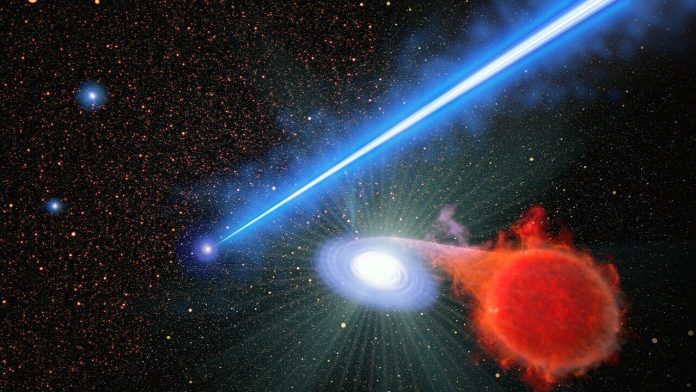
In a surprising discovery, astronomers using the NASA/ESA Hubble Space Telescope have found that a powerful jet of energy from a supermassive black hole seems to be causing stars to explode in a nearby galaxy.
This jet, which shoots out like a blowtorch from the black hole at nearly the speed of light, appears to trigger a higher rate of stellar eruptions, known as novae, along its path.
The research, conducted by Alec Lessing of Stanford University and his team, has been published on the arXiv preprint server.
The findings have left scientists puzzled, as they challenge our current understanding of how black hole jets interact with the space around them.
A nova is a type of stellar explosion that occurs in a double-star system. In such systems, a large, aging star transfers hydrogen to a smaller, dense star called a white dwarf.
When the white dwarf accumulates enough hydrogen on its surface, the gas ignites in a massive explosion, similar to a giant nuclear bomb.
Interestingly, this explosion doesn’t destroy the white dwarf; it simply sheds its outer layer and then starts gathering hydrogen again, beginning the cycle anew.
Hubble’s observations revealed that there were twice as many novae occurring near the black hole’s jet compared to other areas in the same galaxy.
The black hole, located at the center of the massive elliptical galaxy M87, is surrounded by a disk of swirling matter. As this matter falls into the black hole, it powers the jet, which extends 3,000 light-years into space.
Being caught in this jet would be disastrous for anything in its path, but even being close to it seems to be dangerous, according to the new findings.
The researchers noted that stars near the jet are more likely to erupt in a nova, possibly because the jet is pushing hydrogen toward the stars, speeding up the process that leads to these explosions.
One theory is that the jet is somehow funneling hydrogen onto the white dwarfs, causing them to erupt more frequently.
However, it’s unclear exactly how this might work. The researchers considered the possibility that the jet is heating the stars, causing them to spill more hydrogen onto their white dwarf companions, but the amount of heat doesn’t seem to be enough to explain the increase in novae.
Michael Shara, a co-investigator from the American Museum of Natural History in New York City, mentioned that scientists have suspected increased activity around the M87 jet before, but Hubble’s observations provided far more evidence and statistical significance than ever before.
Hubble has been observing the M87 galaxy since shortly after its launch in 1990. Early observations using the telescope’s Faint Object Camera showed unusual activity around the black hole, but the view was too narrow to draw firm conclusions.
Now, with newer, more advanced cameras, Hubble has been able to capture a broader view of M87, leading to this important discovery.
Over a nine-month period, Hubble carefully monitored the galaxy, revisiting it every five days to track the exploding stars. In total, 94 novae were observed in the region that Hubble’s camera could cover.
The data showed a clear pattern: more novae erupted near the jet than elsewhere in the galaxy. This finding was so clear that, as Shara put it, “You didn’t need statistics to convince yourself that there is an excess of novae along the jet.”
This discovery highlights Hubble’s unique ability to peer into the depths of distant galaxies and reveal phenomena that ground-based telescopes cannot see. Novae are quite common in the universe—one erupts in M87 every day.
Given that there are over 100 billion galaxies in the visible universe, this means that around one million novae explode somewhere in the universe every second.
The findings open up new questions about the interactions between black hole jets and their host galaxies, and what this means for our understanding of the universe.
Researchers like Chiara Circosta, an ESA Research Fellow, believe these observations are crucial for expanding our knowledge of how jets from supermassive black holes can influence star formation and other cosmic events.
Source: European Space Agency.



